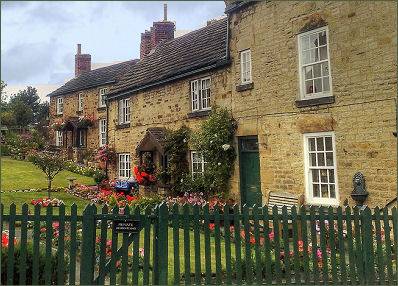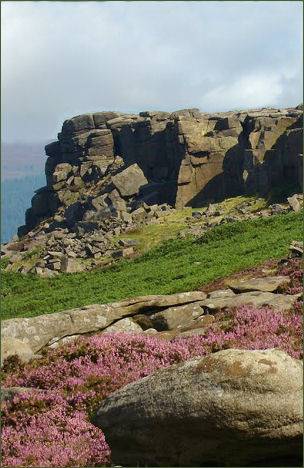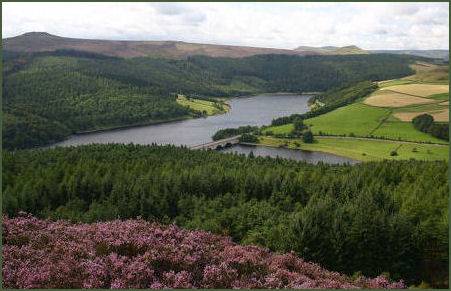South Yorkshire
 The county of South Yorkshire lies on the east side of the Pennine Hills and is landlocked, it borders Derbyshire to the west and south-west, West Yorkshire to the north-west, North Yorkshire to the north, the East Riding of Yorkshire to the north-east, Lincolnshire to the east and Nottinghamshire to the south-east.
The county of South Yorkshire lies on the east side of the Pennine Hills and is landlocked, it borders Derbyshire to the west and south-west, West Yorkshire to the north-west, North Yorkshire to the north, the East Riding of Yorkshire to the north-east, Lincolnshire to the east and Nottinghamshire to the south-east.
The county of South Yorkshire was created in 1974, from districts of the West Riding of Yorkshire and small areas from Derbyshire and Nottinghamshire.
Places of interest in the county include imposing Conisbrough Castle (pictured left) which is situated in the Don Valley. In its present form the castle dates back to twelfth century. The castle's circular keep rises to some ninety seven feet high and is supported by six huge buttresses which dominate the skyline in the Don Valley. The design of Conisbrough's keep is unique in England, and the historians Oliver Creighton and Stephen Johnson consider it an "architectural gem" and "one of the finest examples of late Norman defensive architecture". Its unique design is similar only to Mortemer a French castle near Dieppe that was also owned by the De Warenne family. The castle is reputed to be the inspiration for Sir Walter Scott's famous novel 'Ivanhoe' published in 1819.
Historic Sheffield Manor Lodge is situated around a mile from Sheffield city centre, it was built around 1516 in what was then a large deer park to the east of Sheffield. The lodge was intended as the country retreat of George Talbot, 4th Earl of Shrewsbury and his wife, the famous Elizabethan Bess of Hardwick. The remnant of the estate is now known as Norfolk Park.The remains include parts of the kitchens, long gallery, and the Turret House, also known as "Queen Mary's Tower", which contains fine seventeenth century ceilings. Mary, Queen of Scots was imprisoned at both Sheffield Manor and Sheffield Castle. The Queen of Scots fled to England in 1568 to solicit aid from her cousin Elizabeth I, following her forced abdication from the Scottish throne, when she was replaced by her infant son James, she escaped from imprisonment and met with disastrous defeat at the battle of Langside by the Protestant Scottish lords.
Brodsworth Hall is situated 5 miles to the north west of Doncaster in South Yorkshire and is one of the most complete surviving examples of a Victorian country house in England. Its opulent interior and upstairs-downstairs lifestyle was preserved almost by accident when spiraling costs and lack of staff after World War I meant that parts of the house were simply closed off and time stood still. Cusworth Hall is an eighteenth century Georgian country house on the outskirts of Cusworth, near Doncaster and has been described as the jewel in Doncaster's crown. The beautiful grade 1 listed building is set in acres of historic parkland with lakes, plantations and pleasure ground with dramatic views across the town and is now a country house museum.
Wentworth Castle is situated at Stainborough, near the South Yorkshire town of Barnsley. The castle is the former seat of the Earls of Strafford and was home to the Vernon-Wentworth family until 1949, the beautiful 500 acre estate has been in the care of the Wentworth Castle Heritage Trust since 2002. The estate includes around 60 acres of formal gardens, which reflect gardening fashions and developments from the eighteenth to twentieth century. The highlight of the gardens is the newly restored Victorian conservatory. Additionally, there are 500 acres of parkland, including a deer park and woodland trails, with atmospheric views and majestic follies, including the the Gothic folly of Stainborough Castle and the Ionic Rotunda, there is also an obelisk to Queen Anne and another to Lady Mary Wortley-Montagu to commemorate her introduction of smallpox inoculation to England.
 The stately home of Wentworth Woodhouse stands in the picturesque village of Wentworth, about 4 miles from Rotherham.
The house's east front measures 606 feet (180metres) long, making it the longest country house fašade in Europe. The house covers an area of over 2.5 acres (1.0 ha), nearly one and a half football pitches, is twice as wide as Buckingham Palace and is surrounded by a an estate of 15,000 acres.
It was originally a Jacobean country house, and was the home of Charles 1st's ill-fated administrator, Thomas Wentworth, 1st Earl of Strafford. whom Charles I sacrificed in 1641 to appease Parliament. The original house was rebuilt in the English Baroque style by Thomas Watson-Wentworth, 1st Marquess of Rockingham (1693-1750) who inherited the property from his father, the Hon. Thomas Watson.
The stately home of Wentworth Woodhouse stands in the picturesque village of Wentworth, about 4 miles from Rotherham.
The house's east front measures 606 feet (180metres) long, making it the longest country house fašade in Europe. The house covers an area of over 2.5 acres (1.0 ha), nearly one and a half football pitches, is twice as wide as Buckingham Palace and is surrounded by a an estate of 15,000 acres.
It was originally a Jacobean country house, and was the home of Charles 1st's ill-fated administrator, Thomas Wentworth, 1st Earl of Strafford. whom Charles I sacrificed in 1641 to appease Parliament. The original house was rebuilt in the English Baroque style by Thomas Watson-Wentworth, 1st Marquess of Rockingham (1693-1750) who inherited the property from his father, the Hon. Thomas Watson.
The picture postcard village of Wentworth, (pictured right), perhaps the prettiest village in South Yorkshire, lies around 3 mles to the south of Barnsley. The village boasts attractive cottages and houses of architectural and historic interest. The site of the village stocks in Main Street is now occupied by a telephone kiosk; opposite is the base of the village cross. The estate cottages along Main Street were built from the early seventeenth century onwards. The oldest known cottage, Ivy Cottage, a cruck cottage, is attached to Snowdrop Farm.
The small town of Tickhill is situated 8 miles to the south of Doncaster and lies close to the border with Nottinghamshire. The town boasts several notable buildings including medieval Tickhill Castle, St Mary's Church. which dates back to the twelfth century, the parish room, the old St Leonard's Hospital, and the Buttercross. Tickhill Castle has had an eventful and tumultuous history. It began life as an eleventh century motte and bailey earthwork which was known as Blythe Castle. It was constructed by the Norman magnate Roger de Busli, who is mentioned as a major landholder in the Domesday Survey of 1086.
Abbeydale Industrial Hamlet is a unique eighteenth century industrial museum on the River Sheaf about 4 miles to the south of the centre of Sheffield. The site was used for iron forging for 500 years, although there is evidence of other metal working prior to 1200. Its early history is intimately tied with the nearby Beauchief Abbey, which operated a smithy in the vicinity as well as number of mills along the River Sheaf. Visitors can catch a glimpse of life at home and at work at a rural scythe and steelworks dating back to the eighteenth century. Abbeydale Works was once a producer of agricultural tools and the largest water-powered industrial site on the River Sheaf.
 The county lies largely on the carboniferous rocks of the Yorkshire coalfield which have produced a rolling landscape with hills, escarpments and broad valleys. South Yorkshire's beauty spots include heather clad Stanage Edge (pictured left) a dramatic gritstone escarpment which rises to 458 metres (1,503 feet), the northern part of the edge forms the border between the High Peak of Derbyshire and South Yorkshire.
The stunning view from the gritstone escarpment is one of the most spectacular in the Peak District, extending across the Hope Valley, the Upper Derwent Valley, and towards Chatsworth House which lies to the south, the view to the north takes in dramatic Kinder Scout and Win Hill. In recent years film producers have chosen the edge for the setting of the 2005 film adaptation of Pride and Prejudice starring Keira Knightley, as well as the 2006 BBC production of Jane Eyre.
The county lies largely on the carboniferous rocks of the Yorkshire coalfield which have produced a rolling landscape with hills, escarpments and broad valleys. South Yorkshire's beauty spots include heather clad Stanage Edge (pictured left) a dramatic gritstone escarpment which rises to 458 metres (1,503 feet), the northern part of the edge forms the border between the High Peak of Derbyshire and South Yorkshire.
The stunning view from the gritstone escarpment is one of the most spectacular in the Peak District, extending across the Hope Valley, the Upper Derwent Valley, and towards Chatsworth House which lies to the south, the view to the north takes in dramatic Kinder Scout and Win Hill. In recent years film producers have chosen the edge for the setting of the 2005 film adaptation of Pride and Prejudice starring Keira Knightley, as well as the 2006 BBC production of Jane Eyre.
 Howden Edge which rises 1,787 feet (545 meres) it is the second highest point in South Yorkshire, after Margery Hill. The gritstone peak is situated in the north east of the Upper Derwent Valley area of the Peak District National Park and lies to the north east of Howden Reservoir and to the west of Sheffield. The path which runs along the edge provides superb views of the surrounding moorland. The best way to approach Howden Edge is from the spectacular Upper Derwent Valley. A deep valley surrounded by gritstone edges, it has three reservoirs, the Ladybower Reservoir, which is situated to the south of the valley, the centrally placed Derwent Reservoir and the Y shaped Howden Reservoir to the north.
Howden Edge which rises 1,787 feet (545 meres) it is the second highest point in South Yorkshire, after Margery Hill. The gritstone peak is situated in the north east of the Upper Derwent Valley area of the Peak District National Park and lies to the north east of Howden Reservoir and to the west of Sheffield. The path which runs along the edge provides superb views of the surrounding moorland. The best way to approach Howden Edge is from the spectacular Upper Derwent Valley. A deep valley surrounded by gritstone edges, it has three reservoirs, the Ladybower Reservoir, which is situated to the south of the valley, the centrally placed Derwent Reservoir and the Y shaped Howden Reservoir to the north.
Once part of the hunting and hawking grounds of Rivelin Chase, Wyming Brook Nature Reserve's babbling streams and mossy crags are now a valuable home to wildlife. A winner of the prestigious Green Flag award, the stuniing wooded gorge is situated on the western edge of Sheffield and consists of a very popular wood, glen and moor with well marked paths for walkers, cyclists and horse-riders. The reserve offers easy strolls by the streams or higher,more demanding routes which provide dramatic views of the Rivelin Reservoirs and the city of Sheffield beyond.
The wooded Rivelin Valley stretches for three and a half miles and includes the popular and picturesque Rivelin Valley Nature Trail which runs out towards the Peak District and was created in 1967. The river drops 80 metres between Rivelin Mill Bridge and Malin Bridge and was used from as far back as the fifteenth century as a power source, driving the water wheels of industries along its course. The Valley has 21 artificially created ponds, surviving from the twenty mills which once occupied the riverside. Though most of the mills and forges have not survived, the ponds which used to feed them have.
Situated at the heart of the Dearne Valley, Barnsley, Old Moor Wetland Centre RSPB Reserve is a wonderful place to see wildlife. The centre was opened by Barnsley Borough Council in 1998 as part of the regeneration of the Dearne Valley and then developed further with the help of a lottery grant in 2002. The RSPB took over the management of the site in 2003. The 250 acre reserve is based around several lakes which form marshland and reedbeds, as well as the open water. There is also land based grassland and bushy habitat. There is also a small bird feeding garden which is maintained beside the visitor centre. Picnic areas are provided on various trails throughout the reserve. There are also several bird hides and viewing screens with good views of the main habitats.
Religious edifices in South Yorkshire include Beauchief Abbey, a medieval monastic house now serving as a parish church in the southern suburbs of Sheffield. The Abbey is a place of learning, celebration, worship, history, heritage and community. Beauchief Abbey was founded as a daughter establishment of Welbeck Abbey, due to a gift of land by Robert FitzRanulph, Lord of Alfreton, in about 1176. Thomas Tanner, writing in 1695, stated that it was founded in 1183. However, Samuel Pegge in his History of Beauchief Abbey noted that Albinas, the abbot of Derby, who was one of the witnesses to the charter of foundation, died in 1176, placing foundation before that date. It was dedicated to "God and St Mary and St Thomas the Martyr and to the brothers of the Premonstratensian order". Archbishop Thomas Becket was murdered in 1170 and was canonized in 1173. Tanner stated that Robert FitzRanulf was one of the murderers of Thomas Becket and founded the abbey to expiate his guilt. Pegge also disputed this fact, showing that Robert FitzRanulf had no connection with the murder.
The ruins of Roche Abbey, one of the less well-known Cistercian abbeys, are pleasantly situated beside Maltby Beck, to the south east of the town of Maltby, about 9 miles from Doncaster and 13 miles from Sheffield in South Yorkshire. The abbey was founded in 1147 by Richard de Busli, Lord of Tickhill, who was probably the great-nephew of the first Roger de Busli, the Norman builder of nearby Tickhill Castle, and Richard FitzTurgis. Its first monks came from the abbey at Newminster, in Northumberland and it was they who chose the beck side site. The abbey became a place of pilgrimage due to one of the rocks at Roche bearing a resemblance to the Cross.
Monk Breton Priory, a Scheduled Ancient Monument, is situated in the village of Lundwood, in Barnsley. The priory was founded in 1154 as the Priory of St. Mary Magdelene of Lund by Adam Fitswane, a local landowner. It was a daughter house of St Johns Priory for Cluniac monks, founded by Ilbert de Lacy near Pontefract Castle. Eventually the priory adopted the name of Adam fitz Swain de Bretton, whose family owned much of the land in the area and who also founded the Priory, to become known as Monk Bretton Priory.
